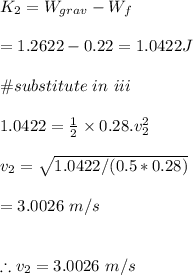
A small rock with mass 0.28 kg is released from rest at point A, which is at the top edge of a large, hemispherical bowl with radius R = 0.46 m (Fig. E7.9). Assume that the size of the rock is small compared to R, so that the rock can be treated as a particle, and assume that the rock slides rather than rolls. The work done by friction on the rock when it moves from point A to point B at the bottom of the bowl has magnitude 0.22 J. (a) Between points A and B, how much work is done on the rock by (i) the normal force and (ii) gravity? (b) What is the speed of the rock as it reaches point B? (c) Of the three forces acting on the rock as it slides down the bowl, which (if any) are constant and which are not? Explain. (d) Just as the rock reaches point B, what is the normal force on it due to the bottom of the bowl?

Answers: 3
Another question on Physics

Physics, 22.06.2019 10:30
The precision of a laboratory instrument is ± 0.05 g. the accepted value for your measurement is 7.92 g. which measurements are in the accepted range? check all that apply. 7.85 g 7.89 g 7.91 g 7.97 g 7.99 g
Answers: 1


Physics, 23.06.2019 00:30
Why does the equilibrium position of the spring change when a mass is added to the spring? will the mass oscillate around the new equilibrium position of the spring or the previous position without a mass attached to the spring? if the equilibrium position of the spring changes by 20 cm (assuming no initial mass) when a mass is added to the spring with constant 4.9 kg/s^2, what is the mass of the object attached to the spring?
Answers: 1

Physics, 23.06.2019 01:00
7types of electromagnetic waves from lowest to highest frequency
Answers: 3
You know the right answer?
A small rock with mass 0.28 kg is released from rest at point A, which is at the top edge of a large...
Questions






Chemistry, 18.01.2021 21:20


Mathematics, 18.01.2021 21:20



















 , and
, and  .
.

 and is not constant.
and is not constant. is constant since
is constant since  and the rock's mass are constants.
and the rock's mass are constants.

![n=0.28[\frac{3.0026^2}{0.46}+9.8]\\\\=8.23 \ N](/tpl/images/0567/5744/b8027.png)


